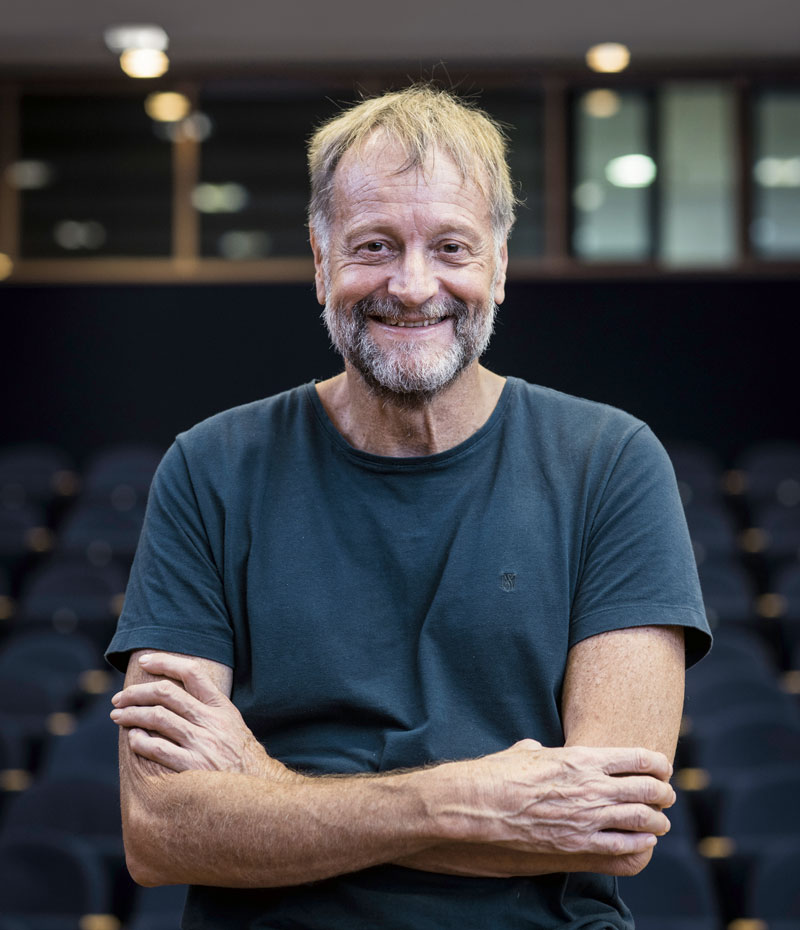Hans Herrmann (UFC Fortaleza and PMMH Paris)
Title: Simulating Saltation
Abstract:
Saltation is the jumping motion of sand grains driven by wind. It is the transport mechanism responsible for the formation of dunes. Wind tunnel experiments and numerical simulation have revealed a rich choreography in the granular dance of saltation. There exist three types of grains, those that crawl on the ground, the “creapers”, those that make many small jumps, the “leapers” which form a soft bed floating above the ground and over which jump through mid-air collisions the “saltons” performing huge jumps with high speed. Mid-air collisions thus manage to increase the total sand flux by over a factor of two. Sustained saltation only exists above a certain threshold in wind speed. At this threshold the saturated flux exhibits a jump and one finds a range of metastable saltation with intermittent bursts of activity that are related to the turbulence of the wind. While on Earth this occurs ten to twenty centimeters above the ground on Mars the saltons can attain heights of up to hundred meters.
Bio (EN):
Born 1954 in Cuba, and raised in Bogotá, he studied physics in Göttingen and Cologne where he made 1978 his diploma and 1981 his PhD in statistical physics and then after one year post-doc in the US went to Service de Physique Théorique in Saclay becoming member of CNRS to which he still belongs today. He was 1990 – 1994 group leader at HLRZ of KFA Jülich, 1994 – 2000, director of the PMMH at ESPCI, Paris; 1996 – 2006, professor and head of the Institute of Computer Physics at the University of Stuttgart and was from 2006 till 2019 full professor at the Institute of Building Materials at ETH Zürich from which he is presently emeritus. Presently he is back at PMMH in Paris and professor at the Physics department of UFC Fortaleza in Brazil. Author of over 700 publications, Guggenheim Fellow (1986), member of the Brazilian (1987) and Colombian (2014) Academies of Science (1987), Max-Planck Research Prize (2002) and Gentner-Kastler Prize (2004), ERC Advanced (2012), Aneesur Rahman Prize (2018), managing editor of Int.J.Mod.Phys.C and Granular Matter and member of several editorial boards and commissions including president of the French Equipment Commission in 2010. Of his former PhD students and post-docs 37 are presently professors. He made lasting contributions to understand fracture of heterogeneous materials and properties of granular media and built a special purpose computer to calculate the conductivity of percolation clusters. Highlights were the discovery of space-filling bearings and the establishment of equations of motion of dunes. His present research subjects include watersheds, neural avalanches, charged granular media and complex networks. (Za https://underline.io/speakers/95680-hans-herrmann)
Bio:
Urodzony w 1954 r. na Kubie i wychowany w Bogocie, studiował fizykę w Getyndze i Kolonii, gdzie w 1978 r. uzyskał dyplom, a w 1981 r. doktorat z fizyki statystycznej, a następnie po rocznym post-doc w USA przeszedł do Service de Physique Théorique w Saclay, stając się członkiem CNRS, do którego należy do dziś. W latach 1990-1994 był kierownikiem grupy w HLRZ KFA Jülich, w latach 1994-2000 dyrektorem PMMH w ESPCI w Paryżu; w latach 1996-2006 profesorem i kierownikiem Instytutu Fizyki Komputerowej na Uniwersytecie w Stuttgarcie, a od 2006 do 2019 roku był profesorem zwyczajnym w Instytucie Materiałów Budowlanych na ETH Zürich, gdzie obecnie jest emerytowany. Obecnie powrócił do PMMH w Paryżu i jest profesorem na wydziale fizyki UFC Fortaleza w Brazylii. Autor ponad 700 publikacji, stypendysta Guggenheima (1986), członek brazylijskiej (1987) i kolumbijskiej (2014) Akademii Nauk (1987), Max-Planck Research Prize (2002) i Gentner-Kastler Prize (2004), ERC Advanced (2012), Aneesur Rahman Prize (2018), redaktor zarządzający Int.J.Mod.Phys.C i Granular Matter oraz członek kilku rad redakcyjnych i komisji, w tym przewodniczący francuskiej komisji ds. sprzętu w 2010 roku. Spośród jego byłych doktorantów i post-doców 37 jest obecnie profesorami. Wniósł trwały wkład w zrozumienie pękania materiałów heterogenicznych i właściwości mediów ziarnistych oraz zbudował komputer specjalnego przeznaczenia do obliczania przewodnictwa klastrów perkolacyjnych. Najważniejszymi odkryciami było odkrycie łożysk wypełniających przestrzeń i ustalenie równań ruchu wydm. Jego obecne tematy badawcze obejmują zlewnie, lawiny neuronowe, naładowane media ziarniste i złożone sieci.

